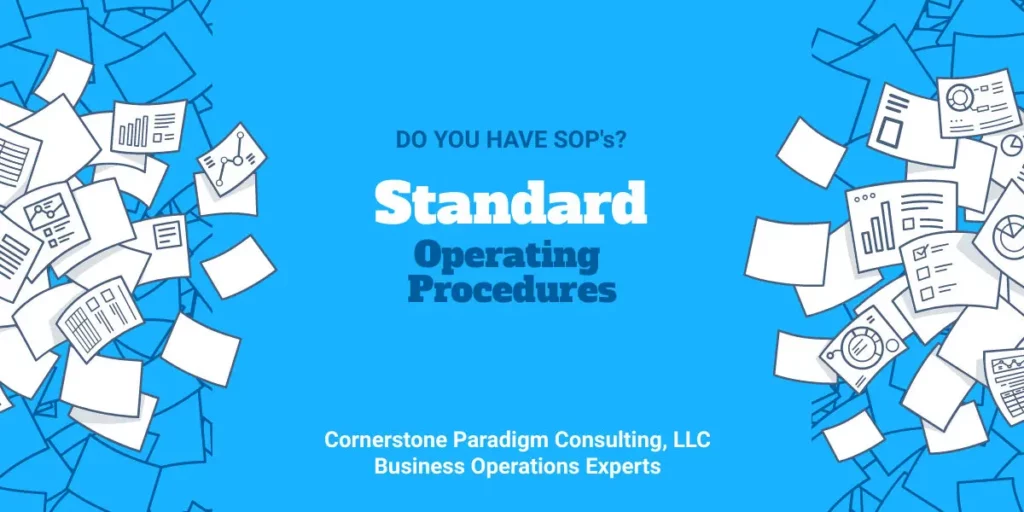Empowering Excellence: The Role of Standard Operating Procedures in Enhancing Business Operations
Since we are a business operations consulting firm, we help our clients solve their problems, including reducing costs, increasing productivity, and improving their customer experience. We help them grow so we can grow with them. Given our expertise, we are often asked to create standard operating procedures (SOPs) documents, which help the employees in the company understand their roles while making their roles more prominent and visible. We believe in the power of SOPs as they not only improve efficiency but also provide a clear roadmap for employees to follow.
As a result, they are well-versed in what needs to be achieved and the optimal timing for each action thanks to the provision of standard operating procedures. Furthermore, SOPs spare no effort in ensuring that employees are aware of their roles and significance. Consequently, the development of SOPs is crucial in upholding the quality of a business’s offerings.
Standard operating procedures (SOPs) are detailed, step-by-step instructions that outline how specific tasks should be performed within an organization. These documents serve as a guide for employees to understand their roles and responsibilities, ensuring consistency and quality in the work being done. SOPs can be created for various departments and processes within a company, such as sales, customer service, or manufacturing.
Creating SOPs involves a thorough analysis of the current processes and procedures in place, identifying areas for improvement and streamlining. This process helps to eliminate redundancies and increase efficiency, saving time and resources for the company. Additionally, with clearly defined SOPs, employees can easily identify their tasks and responsibilities, reducing confusion and increasing productivity.
SOPs also play a vital role in maintaining consistency within an organization. By having standardized processes outlined in SOPs, companies can ensure that every employee is following the same procedures, resulting in consistent quality of work and customer experience. This consistency helps to build trust with customers and improves the overall reputation of the company.
Moreover, SOPs act as a reference guide for new employees, providing them with all the necessary information and guidelines to perform their roles efficiently. This not only helps with onboarding but also saves time and resources in training new hires.
We understand the importance of SOPs in streamlining operations and improving overall business performance.
Here and now, it depends on the process using which the SOPs have been built for a particular organization – whether they are easily understandable or not. The creation of the traditional SOPs is time-consuming, refers to a poor way of managing documentation, and is usually typewritten by individuals from different fields who should not be writing procedures. Not only that, but traditionally created SOPs are visually boring, open to interpretation, and difficult to maintain. While our team is at it, they are experts at building SOPs using process mapping.
Thus, we create SOPs using process mapping, which creates standard operating procedures in a better and more advanced manner. Essentially, a process map alludes to a planning/management tool that visually portrays the workflow. In other words, a process map demonstrates a series of events producing an outcome. Likewise, it indicates who and what is included in a process, can be exercised in any organization, and can uncover areas where a process must be value-added.
Benefits of Process Mapping for Building SOPs
There are many benefits of process mapping for building SOPs; some of them are listed below:
Visibility in Process
Using the mapping process to build SOPs provides visibility in each step of the process. Since process mapping uses visual means, i.e., flowcharts, it is easily understandable and accessible for all the stakeholders and team members. The most crucial part is understanding of employees, which is ensured using process mapping. Furthermore, it contains flowchart symbols for specific processes, making it more visible, less tedious, and easily accessible for the employees and hence making it easier for them to shape their actions according to the SOPs of the firm.
Elimination of Redundancies
Process mapping is an efficient tool for identifying and eliminating redundancies in processes. By visually representing each step, it becomes easier to identify duplicated or unnecessary steps, leading to a more streamlined process and increased productivity.
Continuous Improvement
Process mapping also allows for continuous improvement of SOPs by providing a visual representation of the current processes. This makes it easier to identify areas for improvement and make necessary changes, leading to a more efficient and effective process.
Training Tool
Process mapping can also be used as a training tool for new employees. By providing them with a visual representation of the processes they will be involved in, it becomes easier for them to understand their roles and responsibilities. This not only saves time but also ensures that new employees are familiar with the SOPs from the start.
Time to Develop
Traditional SOPs consume much time to develop: 40+ hours for a business process. However, for a similar detail and comprehension, process maps for SOPs can be built in a couple of hours. Hence, it saves time and resources for the organization, making process mapping a more efficient and cost-effective method for building SOPs.
Consistency
Because different people from different backgrounds often compose traditional SOPs, there are no consistent standards readily accepted. But process maps have predictable and consistent standards and an acknowledged format leading to consistent work process documentation. It ensures the consistency and quality of work, leading to a positive impact on the overall business performance.
Alignment to Work Process
Typically, SOPs are created from the bottom-up, are often confusing and confounding, and present a troublesome way of following work processes. In contrast, SOPs built through process mapping are top-down and hierarchical, starting with business systems, processes, tasks, and knowledge. Apart from that, workflow gets designed straightforwardly into the documentation.
Ease of Maintenance
Customarily, SOPs remain typed instructions and are difficult to maintain, requiring a broad measure of time to rework. Alternatively, if SOPs are developed via process mapping, they represent visual diagrams and outlines effectively modified using symbols, icons, and stencils. This approach makes it easier to make updates and maintain the SOPs in a timely manner.
Are there negatives to having Standard Operating procedures?
We hear this question a lot. While there are many benefits to having SOPs, there may be some drawbacks as well. One potentially negative aspect is that SOPs can sometimes create a rigid and inflexible work environment if they are not understood. This could result in employees feeling restricted or unable to think outside the box when faced with unique situations. To be clear standard operating procedures are merely a tool used to drive consistency for the end product, they are not put in place to hinder creativity, innovation, or invention. Additionally, if SOPs are not regularly reviewed and updated, they may become outdated and irrelevant, leading to confusion and inefficiency. Therefore, it is essential to have a proper review and update system in place for SOPs.
In conclusion, the use of process mapping for building SOPs has numerous benefits that far outweigh any potential negatives. From increased visibility and efficiency to easier maintenance and continuous improvement, process mapping is a valuable tool for any organization looking to streamline its processes. By understanding the importance of SOPs and utilizing process mapping techniques, businesses can create clear, consistent, and effective standard operating procedures that enhance overall performance and success. So, it is safe to say that process mapping is an essential aspect of building SOPs in today’s competitive business world.
Overall, process mapping and SOPs go hand in hand, with each complementing the other in creating an efficient and effective work environment. By utilizing the best practices of both methods, organizations can achieve greater consistency, efficiency, and success in their operations.
Summary
Keeping in mind the facts and points mentioned above, we make sure that we choose the best method for building the base, i.e., process mapping for SOPs. We use our highly skilled and trained team of experts to provide you with the best of our services for ideal processes and give our best to ensure your business effectiveness by streamlining all the steps and tasks through process mapping. We develop your SOPs so that you are able to maintain and manage them as you grow and change along with your process maps.
In addition, we help clients reduce costs by cutting out their outgrown technology, phasing out legacy systems, and stacking multiple technology systems into one system. Lastly, we help them grow by fixing their customer experience using process mapping, design thinking, and user experience while ensuring customers are getting what they are asking for. With our expertise and skills, we are confident that we can provide you with impeccable SOPs through process mapping for your organization’s success.
Overall, incorporating process mapping into SOP building is a smart and innovative approach that can lead to better outcomes for any organization. It not only saves time and resources but also ensures consistency, visibility, and continuous improvement in processes. At the same time, it makes training and maintenance easier and more effective. With these benefits, it’s clear that process mapping is an essential tool for building SOPs and improving business operations. So why not consider implementing process mapping for your organization’s SOPs today? Our team of experts is here to help you every step of the way.
With process mapping, the possibilities are endless – let us help you achieve your business goals through efficient and effective SOPs. Connect with us today.






